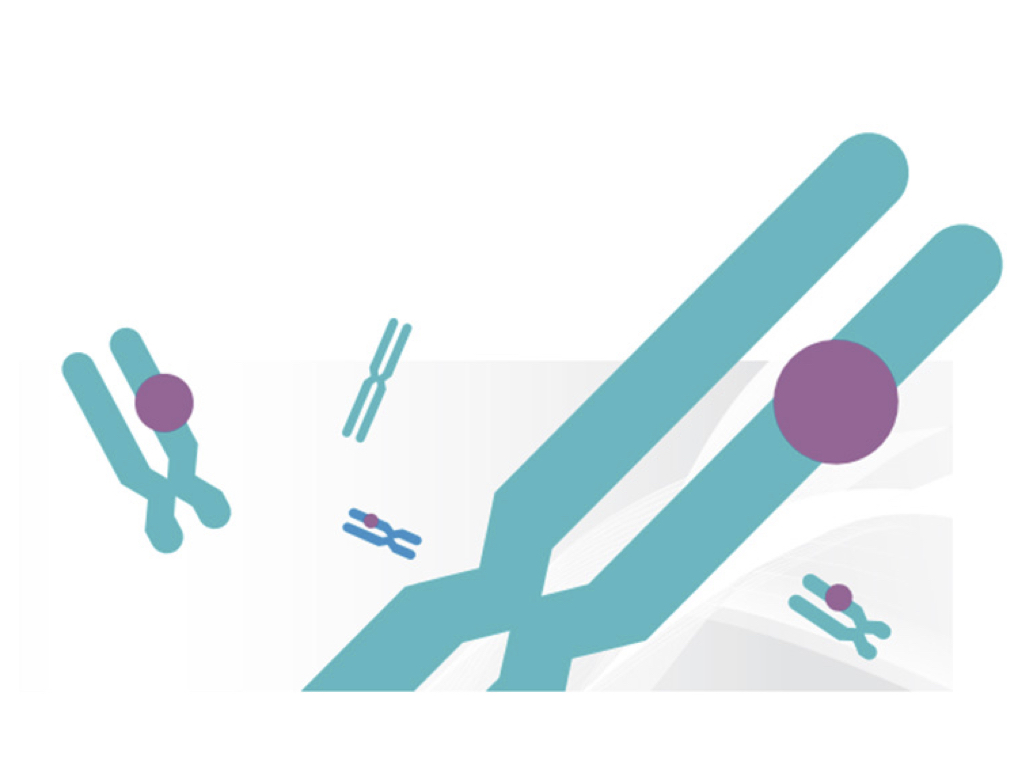A Cytogenetic technique is known as karyotyping determines the number and structure of chromosomes. Based on the size and shape of chromosomes and location of the centromere it is divided into metacentric, acrocentric, telocentric types.
Two important parts of chromosomes are the arms and the centromere. The location of the centromere varies from chromosome to chromosome and that gives variable length to every chromosome.
Henceforth some chromosomes are larger and longer whilst some are smaller, consequently, some have more genetic material and others have less.
The centromere is a central part or portion of the chromosome, a gene less region made up of only repetitive heterochromatin regions. It plays an important role to give the structure of different types of chromosomes. Based on the location of the centromere chromosomes are divided into various categorises.
Difference in the shape of chromosome and location of centromere helps in identification of chromosome.
In the present article, I will explain to you various types of chromosomes revealed through karyotyping.
Related article: What is Karyotyping?- Definition, Steps, Process, and Advantages.
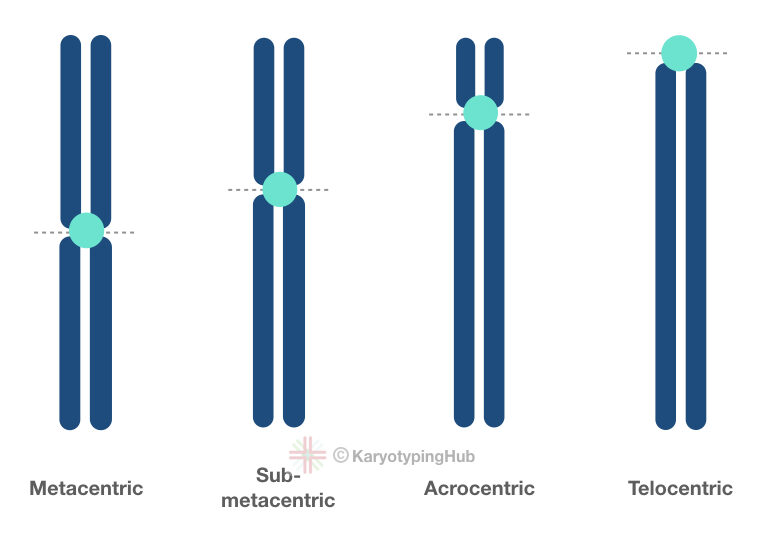
Metacentric chromosomes:
Karyotyping and cytogenetic analysis show that the Metacentric chromosomes are roughly similar in length.
Meta + Centric = Metacentric= Centromere in the middle.
As the centromere is in the middle, the metacentric chromosomes are looked X shaped. And henceforth, the two arms of it are almost similar or equal in length.
The metacentric chromosomes can be further divided into smaller metacentric, larger metacentric and submetacentric.
Chromosome numbers 1, 3, 16, 19 and 20 are categorized into metacentric chromosomes.
In the submetacentric, one arm is slightly smaller than the other but it looks like an L shape in structure.
Note that the translocation of larger chromosomal parts causes the formation of submetacentric chromosomes and that is hard to interpret using the conventional karyotyping technique.

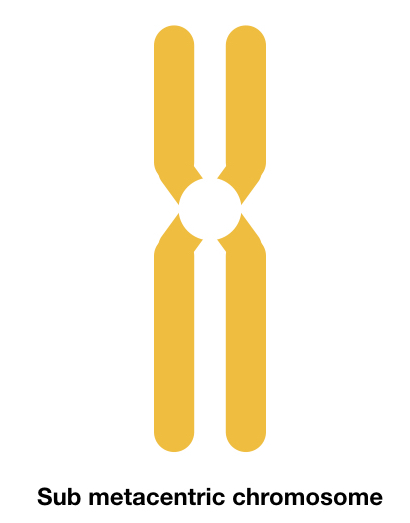
Acrocentric chromosomes:
Chromosomes number 13, 14, 15, 21, 22 and Y chromosome are acrocentric ones in the human genome.
Acro + centric = “acro” means “peak” “centric” means “centromere”.
In the acrocentric chromosomes, the p arm is smaller (nearly not visible) than the q arm. It is so smaller that it’s very difficult to distinguish from telocentric.
The P arm is so smaller and hence is only made up of repetitive- nuclear organizers non-coding regions.
It’s gene-less regions and hence the balanced translocation of it are usually not so harmful to the person. The most popular numerical chromosomal abnormality Down Syndrome is a trisomy of the acrocentric chromosome 21.
Translocation in acrocentric may cause smaller metacentric chromosomes.
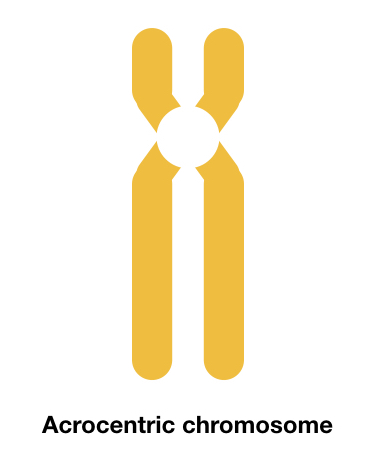
Read more: In which conditions a Karyotyping or a Karyotype Test is preferred?
Telocentric chromosomes:
The telocentric chromosomes don’t have an entire p arm and therefore look like “i” during the cell division. Humans do not have any telocentric chromosomes. While the house mouse has all the telocentric chromosomes.
Note that telocentric chromosomes are naturally not found in human, as it is highly unstable. Break near the centromere and abnormal cell division arises telocentric chromosomes.
Telocentric chromosomes referred to as telosomes, may replaced by normal chromosomes after several cell division (if occurs abnormally).
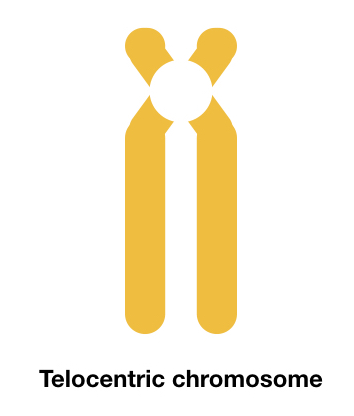
How metacentric, acrocentric and telocentric karyotype can be evaluated?
The technique of standard karyotyping from the blood along with G bands is enough to examine different types of chromosomes. No special setup or technique is required.
However, a special banding technique known as NOR- nuclear organization region banding is often employed to encounter only the acrocentric chromosomes.
It starts with culturing and harvesting metaphse using the standard technique of cell culture. You can read the the article on culture technique here:
After that slides of karyotype are prepared and confirmed using Giemsa staining. Slides are prepared and stored to age for a few days.
After that GTG banding or G bands using trypsin is performed.
The Giemsa stains portions of chromosomes and trypisn digest protein portion of chromosomes, collectively gives different banding pattern of chromosomes.
You can read the whole process and technique of G bands here: GTG banding technique.
G banded slides are observed under microscope to interpret the results. Usually the metacentric chromosomes have more bands on both the ends while other chromosomes have less bands.
The telocentic chromosomes doesn’t have any bands on p arm while only few bands on the p arm of acrocentric chromosomes re observed.
Other technique like Q bands, T bands and NOR banding are also employed to study the karyotype.
Role of centromere and telomere:
Centomere provides variation in the structure and length of chromosomes. Although the telomeres present on the end of arms plays a vital role in human.
The telomers are the repetitive DNA sequence regions that prevent the process of aging, that is the reason the telocentric chromosomes- chromosomes without the telomere are not present in us.
The telomeric and centomeric region are gene less region that protects as well as gives structural stability to chromosomes.
Interesting article: 10 best karyotyping activities and assignments.
Conclusion:
To study cyotogenetics, tirsomies, cancer cytogenetics, it is very important to have knowledge on classification of chromosomes. As a cytoperson, one should have enough expertise to interpret the different type of chromosomes.
It requires hands on training to learn things! We have tried to make to understand the things. I hope this article will help you in your future prospective.
You can read more articles here:
- Is the Y chromosome really disappearing- let’s findout a scientific answer
- 5p deletion syndrome: Why do they cry like a cat?
- Chromosome 2: Genes, Abnormalities and Disorders
- Importance of Metaphase Chromosomes in Karyotyping
- Are Chromosomal/ karyotyping Abnormalities Permanent or Temporary?
FAQs:
What are the four different types of chromosomes based on the location of the centromere?
Metacentric, submetacentric, acrocentric and telocentric are four different types of chromosomes categorized based on the location of the centromere. Note that the telocentric chromosomes are not present in humans.
Do human have telocentric chromosomes?
No, the reason is, that telomere is very important for us as it prevent ageing process. Aslo the telocentric chromosomes are not naturally present because it occurs by breakage or abnormal cel division.
Which organisms have telocentric chromosomes?
House mice have all the telocentric chromosomes.
What is acrocentric chromosome?
Acrocentric chromosomes have very smaller p arm.
Which technique is used to categorize chromosomes?
Cell culture and harvesting (PBLC) in combination with GTG banding or G bands are used to study and classify chromosomes in metacentric, submetacentric, telocentric and acrocentric chromosomes.


